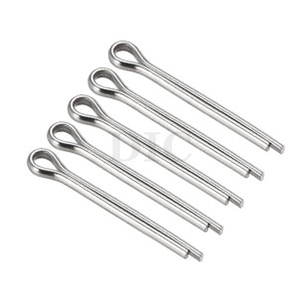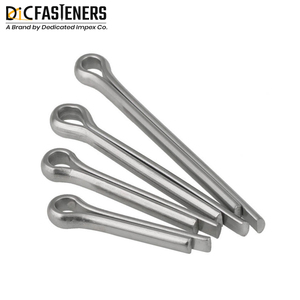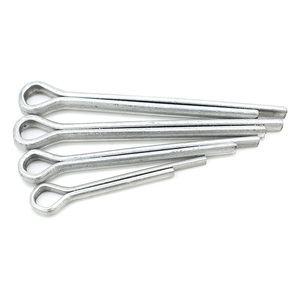
All categories
Featured selections
Trade Assurance
Buyer Central
Help Center
Get the app
Become a supplier

(3381 products available)








































There are two popular cotter pin types commonly used in different industries and applications. Understanding the distinctions in shape and use between these two cotter pins is vital when purchasing hardware in bulk.
Round-centered cotter pins are widely used in various industries because of their function and versatility. Unlike the tapered design, this variety has a uniform shaft width. Therefore, round-centered cotter pins snugly fit the drilled holes in machinery and assembly points. This type of cotter pin is highly valued in mechanical operations requiring moderate load-bearing and rotational movement stabilization.
The pin's two forked ends are tapered for easy insertion. Once installed, the pin ensures that components like nuts, bolts, and pins are firmly secured. The locking ability prevents loosening due to vibrations, a critical consideration in heavy machinery and automotive applications. Round-centered cotter pins are also used in construction, aeronautics, and equipment assembly to hold parts together and maintain safety and reliability.
A tapered-centered cotter pin is characterized by a conical center. The taper enable the pin to be wedged into joints or holes. This design makes it especially useful in applications where heavy loads or significant rotational forces are involved.
The tapered portion of the cotter pin fits into holes of varying sizes, creating a tight, frictional lock. This cotter pin is a favorite among users dealing with high-stress situations. Those include shaft locking in motors, pulleys in industrial equipment, or wheel components in vehicles. Tapered-centered cotter pins are also used to fix and strengthen components in construction equipment, mining machinery, and power transmission systems.
When buying in bulk, it's essential to consider materials used to manufacture cotter pins. Each material is chosen by manufacturers based on requirements like usage, desired lifespan, and operating environment to decide the cotter pin's quality and reliability.
Stainless steel cotter pins are the go-to choice because of their excellent strength, corrosion resistance, and longevity for several applications. It is especially advantageous where the equipment is exposed to moisture, chemicals, or extreme temperatures. Stainless steel pins are thus commonly used in marine, automotive, and aerospace applications. Here, durability is required. In addition, stainless steel pins are also ideal for the food processing industry. This is because they do not contaminate and resist rust, which could easily find its way into equipment.
Standard cotter pins are mostly made from carbon steel, an affordable yet durable option. The material's rigidity and tensile strength make it suitable for numerous applications, such as machinery repairs and construction equipment. Carbon steel cotter pins are treated with zinc or other platings to avoid corrosion, particularly for outdoor or industrial uses. Additionally, users should consider carbon steel cotter pins for dependable and economical solutions.
In the short run, these pins are appropriate for locations with no significant humidity and where temperature variations are not extreme. These pins' cost-effectiveness and durability make carbon steel cotter pins a favorite for large-volume purchases.
Chrome silicon cotter pins are specifically selected by buyers for high-stress applications. The unique alloy of chromium and silicon provides exceptional fatigue resistance, making it ideal for heavy-duty uses in critical assemblies. This material is commonly found in the aerospace, automotive, and high-performance engineering sectors. Here durability and safety are essential. Moreover, chrome silicon cotter pins withstand strong vibrations, dynamic loads, and extreme temperatures.
Several factors come into play when purchasing cotter pins in bulk. Understanding the functional benefits of the kind, the material, and the cost will save buying companies a melodrama down the line.
Application Requirements
What pin works best largely depends on the buyer's application. For light-duty applications, round-centered cotter pins are often adequate since they provide reliable locking without the need for excessive strength. On the other hand, tapered-centered cotter pins are suited for heavy-duty tasks. Such tasks require managing significant loads and rotational forces. These cotter pins are primarily used by automobile, machinery, and construction industries. They demand durable materials that can withstand constant strain.
Material Strength and Corrosion Resistance
Standard cotter pins come in various materials that feature different strength and corrosion resistance. Stainless steel cotter pins are best in outdoor and marine environments because of their resistance to rust and corrosion. At the same time, carbon steel pins are economical and strong, ideally suited for indoor use or where exposure to harsh elements is less likely. Pins made from chrome-silicon alloy are tough and fatigue-resistant. This makes them ideal for critical applications in aerospace and high-performance engineering.
Cost Considerations
Copper pins are typically more affordable than other hardware options. Their price is influenced primarily by the material used. Carbon steel cotter pins are often the most cost-effective, offering excellent strength for general-purpose use. But, of course, they are not as resistant to corrosion as the others.
On the other hand, stainless steel pins, while higher in cost, deliver value through their longevity and reliability in adverse conditions. What about chrome silicon pins? Due to the rarity of the material, they tend to be more expensive. Although, their superior performance in critical applications can offset the costs in the long run.
Size and Compatibility
Cotter pins come in various sizes. All of which are suitable for particular applications and equipment. When buying in bulk, one must ensure that the pin size is compatible with the customer's equipment. Also, one should pay close attention to the pin diameter and the length of the two prongs. A good cotter pin should fit snugly in the holes or slots of the machinery. A loose or tight pin will lead to equipment failure or disrupt operations.
Cotter pins hold and secure components across industries, preventing parts from shifting or coming loose. These pins find diverse applications.
Agricultural Equipment
Standard cotter pins are important for securing critical components in large-scale farming activities. Because of this, they are preferred in agriculture. In addition to ensuring safety, the cotter pins help avoid mechanical failures, hence increasing efficiency in farming. The pins are used to fasten parts like gears, sprockets, and linkages on tractors, harvesters, and other farm machinery. Standard cotter pins are essential to the farmers' daily equipment maintenance, longevity, and performance. This makes them a preferred long-term investment for agricultural businesses.
Aerospace and Aviation
In aerospace, cotter pins make all the difference between safety and danger. For example, Tapered-centered cotter pins are favored for their high strength and fatigue resistance. Because of their operating standards, aerospace and aviation applications require pins that can continuously endure dynamic loads and incorporate extreme environmental elements. They secure critical components like fasteners, gears, and pins in aircraft and spacecraft. Hence, they prevent unwanted loosening or shifting during flight, which can have catastrophic consequences. Therefore, these pins not only ensure proper working but also contribute to safety and reliability in the air travel experience.
Heavy Machinery
Cotter pins are the unsung heroes in heavy machinery as they are widely used in large industrial equipment. Like the tapered variety, these pins are considered very valuable due to their strength and ability to endure intense working conditions. They are mainly used to secure parts like shafts, pulleys, and wheels in mining and construction machinery. Here, the machinery undergoes massive loads and vigorous activity.
Furthermore, cotter pins help in distributing the loads across the pinned components. This leads to less wear and tear and increases the lifespan of expensive heavy machinery.
Marine
In naval and marine, cotter pins are crucial to securing components in machinery and boats. Pins made of stainless steel are primarily used because of their superior resistance to corrosion. They are used to secure parts like rudders, propellers, and shafts in boats, ships, and submarines. These pins help maintain the integrity of critical systems by preventing components from loosening due to constant movement and exposure to harsh seas. Since marine clients value longevity and reliability in their equipment, standard cotter pins are fundamental to their maintenance and operations.
Although clevis and cotter pins do similar functions, they are different hardware items. A clevis pin has a U-shaped fork on one end, with two parallel ridges or "eyes." This design allows the clevis pin to be attached to other components using a cotter pin or a similar fastener to secure it. On the other hand, the cotter pin is a simple fastening device. Sometimes referred to as a safety fastener. It is mostly used to secure clevis pins or other fasteners, bolts, and machinery components. A cotter pin is often inserted into a hole or groove and bent at the ends to hold it in place. In short, clevis pins are meant for heavy-duty industrial applications. Meanwhile, cotter pins have a more general function of securing parts in multiple contexts.
Heavy-duty machinery has to bear colossal loads, which translates to vigorous vibrations and dynamic forces. Cotter pins hold vital components in such an environment. They help secure shafts, gears, and pulleys, among other parts. Without these pins, machinery would often suffer part displacement, leading to mechanical failures, downtime, and even safety issues. In essence, cotter pins not only ensure the equipment runs smoothly. They also reduce wear and tear on parts, increase maintenance intervals, and improve reliability in the long term.
To put it bluntly, cotter pins are durable. However, they will eventually need to be replaced. Regularly inspecting pe's will help address the issue before it becomes a problem. Signs that it's time to replace a cotter pin include noticeable bending, corrosion, or rust. Other warning signs include cracks or breaks in the material. If the pin is heavily worn or has lost its shape, it can no longer perform its fastening role safely. In heavy-duty applications, users should also replace cotter pins periodically, as pins can undergo immense stress and strain. It ensures that equipment remains safe and operational.